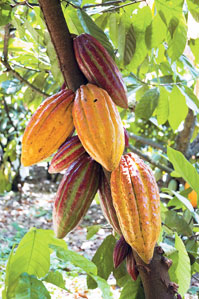
Cocoa: fermented seeds produce aroma and flavor associated with chocolateEDUARDO CESAR
A recipe created in inner-state of Sao Paulo could improve the final quality of the Brazilian cocoa that is earmarked for chocolate production. A team of researchers from the University of Sao Paulo (USP) in the city of Piracicaba believes it has found a way to reduce one of the less attractive traits of the seeds of this fruit planted in Brazilian soil: its high acidity level. This undesirable feature is due to the incomplete fermentation of cocoa seeds. This process usually occurs spontaneously at the cocoa-producing plantations, and is triggered by fungi found naturally in the fruits. To get round this problem, the scientists came up with a fermentation kit, which includes a hybrid yeast of the Kluyveromyces marxianus species. Thus, the scientists managed to gain greater control of this stage of production and reduce the acidity of the cocoa pulp by about 25%.
“The kit is simple, but it works well”, declares agricultural engineer Flávio Tavares, from Esalq, the University of São Paulo’s College of Agriculture, who is an expert in microorganism genetics and the creator of the new yeast. The kit was tested on a small scale at two plantations in the Ilheus region, in the south of the state of Bahia, a traditional cocoa growing area. According to tests carried out by the scientists with 30 consumers, the quality of the chocolate obtained from the cocoa fermented with the K. marxianus strain of yeast was superior to that of the chocolate produced using naturally fermented cocoa. The results of this research are set out in the August edition of the journal FEMS Yeast Research. In order to protect their fermentation method, the researchers have filed a request for a patent with Brazil’s National Institute of Industrial Property (INPI).
The fermentation stage, which precedes the well-known one of the drying of the cocoa seeds, is responsible for producing the precursors of the aromas, flavors and even of the color associated with chocolate. Without proper fermentation, one does not get good cocoa pulp, an essential ingredient for high quality chocolate. Cocoa which is not fully fermented usually results in chocolate with a rawer, more acidic flavor, which consumers dislike. The new yeast seems to have a beneficial effect because it attacks the factor that keeps the seeds from fermenting properly: it reduces the excess pulp on the beans of the fruit. This mucilage, which can account for around 40% of the seeds’ raw weight, prevents full aeration of the cocoa seeds, thus hindering fermentation. Theoretically, getting around this problem is easy. It is necessary to remove the excess pulp from the seeds either mechanically or with chemical agents, such as certain enzymes. “The problem is that doing this on a large scale entails high costs for cocoa producers”, explains Antonio Figueira, from Piracicaba’s Center of Nuclear Energy in Agriculture (Cena-USP) and a co-author of this project. The solution was to look for an efficient, lower-cost alternative.
Originally developed at Esalq to clarify juices and fructose syrups made from tubercles, the hybrid variety of the yeast K. marxianus proved to be useful in the fermentation of cocoa seeds due to its high pectinolytic activity. In straightforward language, this means that the yeast can properly break down the pectin, an abundant polysaccharide in the pulp’s cell walls. The yeast transforms the pectin into lesser, easier-to-ferment sugars. “Using the yeast, we tried to break down the pulp quickly, in order to aerate the cocoa pulp and help fermentation”, explains Tavares. During the experiments conducted at a cocoa plantation in Bahia, the researchers found very tangible evidence of the hybrid yeast’s effect: in the fermentations induced by K. marxianus there was a one third increase in the production of the so-called cocoa honey, a sugar-rich liquid derived from the pulp, relative to natural fermentations. Another indication was the increased presence of brown seeds at the end of fermentation stimulated by the hybrid yeast, as compared to natural fermentation. The darker color is informal evidence that there has been fermentation in the seeds. In chemical terms, the researchers obtained another piece of information that points to the beneficial effects of K. marxianus: they managed to show lower presence of acids (particularly lactic and acetic acids) in the fermented seeds.
It is not just any old yeast that has an effect on cocoa fermentation: there must be a microorganism that remains active under the conditions in which this process takes place. Both empirical and complex, fermentation takes between five and seven days, entails a number of chemical reactions (some only occur in the presence of oxygen while others do not require it) and can raise the temperature of the cocoa pulp to 50ºC. To complicate the situation further, a series of microorganisms naturally present in the fermentation environment – various species of yeasts, other types of fungi and lactic and acetic bacteria – usually begin the process spontaneously. Therefore, to be effective, any yeast introduced by man into the fermentation process must be able to deal with these variables and yet still keep control of the process. The new strain of K. marxianus seems to be able to cope with these tasks. “Now we want to test it on a larger scale, in large plantations, to see if the results remain the same”, says Figueira.
Scientific article
LEAL JR., G. A., et al. Fermentation of cocoa (Theobroma cocoa L.) seeds with a hybrid Kluyveromyces marxianus strain improved product quality attributes. Fems Yeast Research. v. 8, p. 788-798, Aug.2008.
